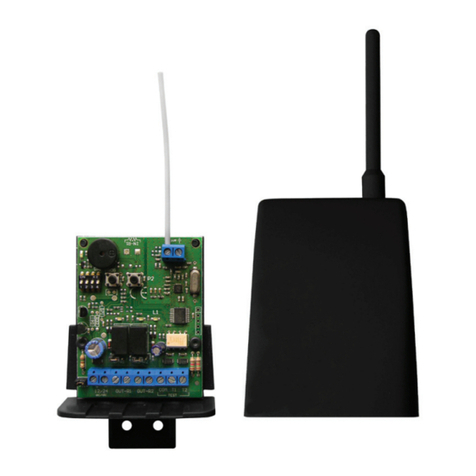
TRANSCEIVER v2 Manuale tecnico
-7-
Confi gurazione a controllo attivo
DIP-1 OFF sia su TX che RX
Il sistema utilizzato come sicurezza per le
automazioni risponde alle nomative vigenti solo se
viene eseguito il test dalla centrale all’inizio di ogni
manovra utilizzando gli ingressi test.
Ingressi TEST
Collegare agli ingressi test il COMUNE (negativo),
e l’uscita FOTOTEST dalla centrale elettronica
dell’automazione.
• Con il DIP-2 del RX in OFF il RICEVITORE
eseguirà il test di trasmissione e ricezione
quando sugli stessi ingressi test è applicata una
tensione.
• Con il DIP-2 del RX in ON il RICEVITORE
eseguirà il test di trasmissione e ricezione in
mancanza di tensione sugli stessi ingressi test.
In questa confi gurazione si verifi ca un controllo
attivo della sicurezza e del sistema a norma di
legge, la ricezione del segnale da parte del TX è
sempre attiva e di conseguenza ci sarà un consumo
maggiore delle batterie.
Nel caso di 2 LR06 AA 1,5V la durata è di circa 12
mesi.
Confi gurazione a controllo passivo
DIP-1 ON sia su TX che RX
In questa confi gurazione si verifi ca un controllo
passivo detto pure: “CONTROLLO STATO IN VITA”
della sicurezza, la ricezione del segnale da parte del
TX si attiva ogni 12 secondi. Se dopo 30 secondi il
RICEVITORE non ha ricevuto la comunicazione di
stato in vita di un TX, il RICEVITORE pone in allarme
l’uscita a cui è associato il TX.
Installazione
Se si sceglie di operare con questa confi gurazione
si consiglia di eseguire l’installazione con DIP-
1 OFF sia su TX che RX in modo da eseguire il
test di funzionamento con il sistema CHECK e poi
impostare DIP-1 ON sia su TX che RX.
Ad impianto già installato al momento dell’accensione,
il ricevitore attende la trasmissione periodica dello
stato in vita dei TX appresi, quindi attiverà l’uscita
entro un tempo di 10 secondi, se questi non sono
presenti o non funzionano si deve attendere qualche
secondo ancora, prima che il ricevitore fi nisca la
ricerca (LED-RX1 rosso si spegne). Questo vale
anche se si esegue il TEST (FOTOTEST) da
centrale, vedi descrizione precedente, l’uscita verrà
riattivata entro 10 secondi.
Questa confi gurazione comporta un consumo del TX
molto inferiore rispetto la precedente. Nel caso di 2
LR06 AA 1,5V la durata è di circa 24 mesi.
Test
Quando si attiva il test tramite gli ingressi test (vedi collegamenti descritti precedentemente), il ricevitore pone
in allarme l’uscita se tutti i TX associati vengono rilevati, pone l’uscita in stato normale quando il test viene
disattivato.
Uscite OUT1 e OUT2 RX
Sono in stato di normalmente chiuso N.C. oppure a 8,2k quando non si è in allarme. E’ presente un led relativo
a ciascuna uscita sempre acceso quando l’uscita è nello stato normale non allarmata. Se si utilizza l’uscita in
modo resistivo è normalmente a 8,2k e in stato di allarme è un contatto chiuso. L’impostazione del tipo di uscita
è settata tramite JUMPER N/R1 NC/NA e JUMPER N/R2 NC/NA posizionati sotto gli stessi relè.
Modalità di funzionamento




























